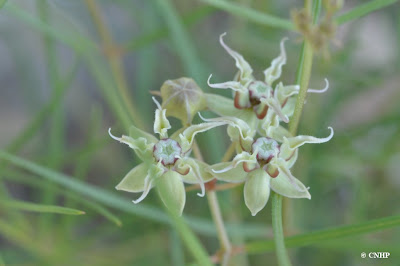long-hood milkweed
G4 S2
CNHP director Dave Anderson took these photos of the long-hood milkweed during the JE Canyon bioblitz. This species is considered rare in Colorado, and occurrences are tracked by CNHP.
Asclepias macrotis is a member of the Milkweed family. Nearly all Asclepias have latex canals that when broken release a milky fluid, hence the common name "milkweed" for the genus. The genus Asclepias is also familiar to many as the food of monarch butterfly larvae. Milkweeds are characterized by a specialized floral structure and pollination mechanism. Milkweed flowers have five showy petals that are typically bent severely downward (reflexed). Below the petals are five (usually greenish) sepals. Above the petals is an additional whorl of floral structures called "hoods" that arise from bases of the stamens. Each hood usually contains an inward arching "horn" that serves as a nectar reservoir. The hoods and horns together form the corona, an additional floral layer above the corolla. Asclepias macrotis has long, slender hoods (macrotis means "long-eared", and is often part of the scientific name for some species of bats and other animals that have long ears).
My, what long ears you have.
In Colorado, this milkweed is at the northern edge of its range. Populations are known from Las Animas, Baca, and Bent Counties in Colorado, and the species is also known from southern Arizona, New Mexico, and parts of Texas and the Oklahoma panhandle adjacent to New Mexico. Colorado populations are typically found on sandstone rimrock, rocky shale, or rocky slopes of eroded sandstone in the canyon country of the southeastern corner of the state. Here they grow in sparsely vegetated areas of one-seed juniper (Juniperus monosperma) and native prairie grasses such as the grama grasses (Bouteloua spp.) and needle-and-thread (Hesperostipa spp.)





No comments:
Post a Comment
Thanks for your comment!
Please note that all comments are moderated, so there may be a delay of some hours (especially over the weekend or at night Colorado time) before your comment shows up.